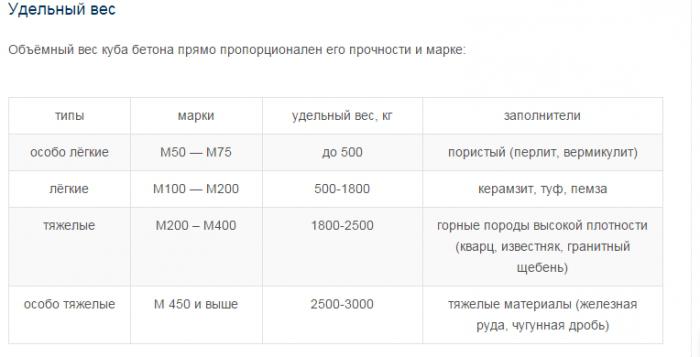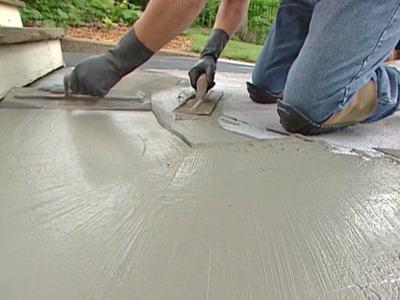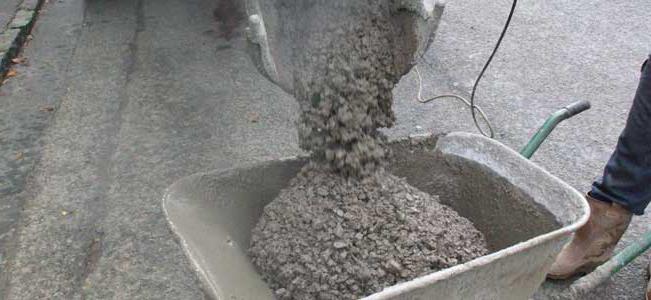Specific gravity of concrete is m200 and m300, how much does a cube of concrete weigh, volumetric weight of concrete. Specific gravity of concrete
Answer:The theoretical determination of the weight of a cube of a building mortar is complicated by the fact that solutions can have several components (complex solutions), different ratios of these components, as well as different types of sand by grain density.
The weight of 1 cubic meter of solution directly depends not only on its components, but also on humidity. According to GOST, according to average density, solutions are divided into light and heavy. Light mortars include mortars with a volume weight of less than 1500 kg / m 3. Heavy solutions, respectively, include solutions with a bulk density of more than 1500 kg / m 3. Heavy solutions are prepared on aggregates with a bulk density of more than 1200 kg / m 3 and when hardened they have greater strength and density. Light solutions due to the presence of multiple air pores have less thermal conductivity. The weight of the solution cube also depends on the size of the aggregate grains, as well as on the particle size distribution - the ratio of aggregate grains by size. The largest volume weight aggregate and, as a consequence, the solution will be if a certain ratio is observed between the number of grains of different sizes. For example, 1 m 3 of sand with grains with a diameter of 1 mm weighs about 1400 kg, and from a mixture of grains of 0.15-5 mm it already weighs 1600-1700 kg.
And if we take into account that sand is not the only type of aggregate, we can conclude that the weight of a cubic meter of a complex solution can only be established experimentally, by weighing vehicles or tentatively using tables:
Tab. Weight of 1 cube of solution depending on the type of binder and fillers
|
The name of the solutions |
Weight 1 cube |
|
Cement-sand mortar |
1800 |
|
Complex solution (sand, lime, cement) |
1700 |
|
Lime-sand mortar |
1600 |
|
Cement slag mortar |
1400 |
|
Cement perlite mortar |
1000 |
|
Gypsum perlite solution |
600 |
|
Porous gypsum perlite mortar |
500 |
Concrete is a rather heavy building material, the exact mass of which depends on many components. Specific gravity concrete determines its quantitative composition. In other words, the percentage of cement, water, sand and gravel may vary depending on the final purpose of the solution.
What is the specific gravity of concrete
The resulting building mixture hardens quickly, and it must be used immediately after manufacturing. In order to avoid wasting time and raw materials, you need to accurately calculate the volume of the resulting solution. This will not work quickly, as the mixture is notable for its rather complicated composition. To find out the specific gravity of concrete, you need to add the specific gravity of its components. To do this, you need to know all the components of the mixture and their percentage in solution.
Cement is the basis of concrete
The main component of concrete mixes is cement. The density of fresh cement varies in the region of 1100-1200 kg / m 3, caked cement mixture has a density of about 1500 kg / m 3. In production reinforced concrete products the average cement density of 1300 kg / m 3 is used in the calculations. The reasons for this discrepancy are due to the presence of free space between the particles of matter. The larger they are, the more air voids the cement contains and the less its specific gravity.
It also matters the filler, which is added to the concrete mixture. It can be light tuff or expanded clay with voids inside, which greatly facilitate the weight of the finished solution. A large amount of sand and gravel makes concrete more dense and heavy.
Types of concrete
Depending on the percentage of solids in the solution, the concrete mixture can be particularly light, light and heavy.
A particularly light form of this building material has a density of up to 500 kg / m 3. The specific gravity of the concrete belonging to the light category varies in the range of 500-1800 kg / m 3. Both types of concrete are quite similar in their characteristics and are known as expanded clay concrete, wood concrete, perlite concrete, foam concrete, aerated concrete and others.
Heavy mixtures are known by the names of crushed stone, gravel or barite concrete. Their density reaches 2500 kg / m 3, sometimes a little higher.
Different types of concrete have their own characteristics and are used for very specific tasks. The heavier this building material, the less various voids in it. An increase in the density of this substance leads to an increase in its strength and a decrease in frost resistance.
To accurately calculate the required characteristics of the mortar, you need to know the specific gravity of concrete. The table of the most popular brands of this component is shown below: 
Volume weight
To accurately determine the specific gravity of concrete, it would be necessary to grind it to a powder state. Technically, this task is difficult to accomplish. Therefore, few people care about determining the specific gravity concrete mortar one or another brand. In construction, another characteristic of this material is in use - bulk density concrete. This value is calculated by simply dividing the weight of concrete by the volume it occupies.
Concrete marking
The main characteristic of a concrete mortar is its compressive strength. IN technical specifications of this material, this characteristic is indicated by the letter "M". Depending on the purpose of the concrete mix, this material may be labeled from M100 to M500. The most common are concrete class M200, M300, M400. The main characteristics of these solutions are discussed below.
Concrete brand M200
One of the most common types of ready-mixed concrete is concrete M200. Building material of this variety is used when pouring staircases and foundations, when arranging paths and floor screeds, in various building structures. The indicator 200 after the letter M indicates that this brand of concrete can withstand a load of about 200 kg-forces / cm 2. 
M200 belongs to the category of lightweight concrete. The relatively low density is explained by the presence of various hollow additives, for example, pumice and expanded clay. The specific gravity of M200 concrete depends on the amount of water in the resulting solution and on the density of the initial aggregate - crushed stone or sand. Basically, this indicator ranges from 1500 kg / m 3.
The composition of the concrete mix M200 includes:
- cement grade 400-500 - 1 part;
- water - 42 liters of water should go per 10 liters of dry mix;
- sifted sand - 2.8 parts;
- granite, calcareous or gravel gravel of small fractions - 4.8 parts.
Sometimes, various components are added to the composition of the concrete mixture, which make it possible to improve certain characteristics of the finished concrete solution.
From 10 liters of cement 54 liters of ready-mixed concrete are obtained.
Concrete M300
This is a common brand with a wide range of applications. M300 is used for the construction of airfield coatings, roadbedfoundations, bridge floors and much more. The specific gravity of concrete M300 is 1.8 t / m 3. 
The composition of concrete M300 is given below:
- cement of grades 400 or 500 - 1 part;
- gravel, granite or limestone aggregates - 3.7 parts;
- sifted sand - 1.9 parts;
- water - up to 32 liters per 10 liters of dry mix.
In this type of concrete, lightweight aggregates yield their mass fraction to heavier elements. Although this brand of concrete already belongs to the medium density category of concrete mixtures.
The amount of finished concrete from 10 liters of cement is 41 liters of concrete M300.
Concrete M400
Concrete M400 is used for moisture resistant processing. It is strong enough and hardens very quickly. The composition of the material of this brand includes:
- cement grades 400-500 - 1 part;
- sand - 1.2 parts;
- crushed stone of medium fractions - 2.7 parts;
- about 10 liters of pre-concrete mix should spend about 24 liters of water.
The specific gravity of concrete M400 is about 2000 kg / m 3.

The difference in the specific gravity of concrete directly depends on its components. For example, M200 medium concrete can be classified as light or heavy, depending on which particular filler is in its composition. Light tuff or expanded clay make the specific gravity of concrete small; crushed stone allows this variety of construction mix to be classified as a heavy category.
Do I need to buy cement for future use
Concrete is a quick-hardening mortar; for the future, of course, you cannot procure it, but you should not buy cement in advance in large quantities. Fresh cement mix crumbles quickly enough, while significantly losing its properties. In order to check the freshness of the cement, just squeeze a handful of the mixture in the palm of your hand. Fresh material behaves like dry sand and spills out through your fingers. If lumps formed after compression, it means that cement has already lost some of its qualities, and it must be used as quickly as possible. 
Correctly selected composition of the concrete mixture will not only facilitate the work, but also save time and construction costs.
A feature of most building materials, including concrete, is the presence in them of pores of different sizes and origin. These pores make it difficult to measure the specific gravity of the material, because to obtain accurate data you need to weigh an absolutely dense sample.
And this means that in order to determine the specific gravity of concrete, a considerable sample would have to be crushed into fine dust. Agree that this is quite difficult to perform technically and is required only in case of serious research and engineering calculations.
Specific and volumetric weight of concrete m200 and m300, the weight of a cubic meter of concrete
It is for this reason that no one is trying to find out the specific gravity of concrete m200 , m300 or other common brands. Usually use a different characteristic - bulk density of concrete.
This indicator is calculated by measuring the weight of the finished concrete in a certain volume, while its value can vary greatly, depending on the filler, the presence of pores, air or gas bubbles.
Weight per cubic meter of concrete can range from 500 to 2500 or more kilograms per cubic meter. According to this indicator, concrete is divided into light, medium and heavy.
Volumetric weight of concrete grades m200 and m300 usually range from 2300-2500 kilograms per cubic meter, and they are classified as heavy concrete. All concretes with crushed stone filler belong to the same group.
Medium concretes have expanded clay, tuff, perlite, aramsite as a filler, so the weight of a cubic meter of such concrete is significantly less - 1200-1800 kilograms.
And the lightest concrete is foam and aerated concrete, produced in the form of finished blocks. Such concrete is prepared without aggregate, moreover, pores are artificially created in it to reduce the thermal conductivity and weight of the finished blocks.
How much does a cube of concrete weigh, 1m3 of concrete
It should be understood that pores are formed in other types of concrete after the evaporation of the water included in its composition. For this reason, if you want to know how much does it weigh concrete cube, you don’t need to drive into the search line a query like “specific gravity of concrete m300” and the like. And use the indicator of volumetric weight, as well as for sand, gravel, brick and many other materials.
Many people mistakenly believe that the stronger the concrete, the greater its weight, i.e. strength can be judged by how much does a cube of concrete weigh, but it is not so.
The strength of the building grades of concrete mainly depends on the brand of cement used in the mortar, and the weight on the nature, quantity and fraction of the filler.
For example, concrete with a filler in the form of granite chips or sandstone will be classified as heavy, and claydite concrete with the same content of sand and cement will be medium, or even light.
If you really need to still find out the specific gravity of any concrete, then it can be approximately calculated by adding the specific gravities of each of the components proportionally to the content: sand, cement, filler, water. Be sure to also consider chemically bound water in this case.
Weight depends on the density of all elements and can be in the range of 300-3000 kg.
Thermal insulation (especially light)
Such material is made of cement and fillers, when mixed, a structure is obtained with the presence of voids of about 85%. It is used for the manufacture of structures with special requirements for thermal conductivity (while they are not able to withstand significant bearing loads). This category includes mixtures with a weight of up to 500 kg per cubic meter. In some cases, they are used to increase their strength.
It is worth considering the low resistance of porous structures to the effects of frost. When installing them, it is necessary to install waterproofing protection.
Easy
This classifies a solution with a mass in the range of 500-1800 kg. It is mainly used to create special building blocks in the structure of which pores are present - they can be formed with the help of blowing agents or be caused by the use of cellular fillers (expanded clay for example).
Only can exactly match the specified mass and brand.
Heavy
- one of the most common in construction. It is ideally suited for the construction of structural components that perform a supporting function. The weight of the cube in this case can be 1800-2500 kg - this indicator completely depends on the percentage of sand and coarse aggregate, as well as the density of the latter (even when using granite and gravel aggregate in the same amount, the total weight of one cubic meter will be different).
Heavyweight (Extra Heavy)
For its manufacture, metal fillers are used, which increases the weight characteristics to a maximum aisle per 1 cube - a little more than 3000 kg. Such mixtures are used to prevent the spread of radiation through walls.
The production of heavy mixtures involves the use of materials quite specific to the construction, the cost of which will make the construction of the house quite expensive. That is why they are used exclusively in the construction of facilities with increased requirements for protection against radiation.
Bulk Weight Table
If we compare the weight indicators in volume and specific ratio, it turns out that volume M200 weighs just like concrete M250.
Specific gravity table
Now you know how much a cube of concrete weighs a particular brand. Just keep in mind that it is possible to achieve exact compliance with the characteristics during its factory production.




